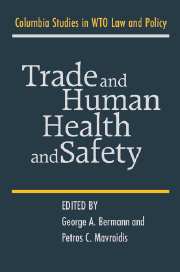Book contents
- Frontmatter
- Contents
- Preface to the Series
- Introductory Remarks
- 1 A Map of the World Trade Organization Law of Domestic Regulation of Goods
- 2 The WTO Impact on Internal Regulations: A Case Study of the Canada–EC Asbestos Dispute
- 3 Reflections on the Appellate Body Decision in the Hormones Case and the Meaning of the SPS Agreement
- 4 The Salmon Case: Evolution of Balancing Mechanisms for Non-Trade Values in WTO
- 5 Lotus Eaters: Reflections on the Varietals Dispute, the SPS Agreement and WTO Dispute Resolution
- 6 Regulatory Purpose and “Like Products” in Article III:4 of the GATT (with Additional Remarks on Article III:2)
- 7 The WTO Standard of Review in Health and Safety Disputes
- 8 Expert Advice in WTO Dispute Settlement
- 9 Domestic Regulation, Sovereignty and Scientific Evidence Requirements: A Pessimistic View
- 10 Time for a United Nations' “Global Compact” for Integrating Human Rights into the Law of Worldwide Organizations: Lessons from European Integration Law for Global Integration Law
- Index
9 - Domestic Regulation, Sovereignty and Scientific Evidence Requirements: A Pessimistic View
Published online by Cambridge University Press: 27 July 2009
- Frontmatter
- Contents
- Preface to the Series
- Introductory Remarks
- 1 A Map of the World Trade Organization Law of Domestic Regulation of Goods
- 2 The WTO Impact on Internal Regulations: A Case Study of the Canada–EC Asbestos Dispute
- 3 Reflections on the Appellate Body Decision in the Hormones Case and the Meaning of the SPS Agreement
- 4 The Salmon Case: Evolution of Balancing Mechanisms for Non-Trade Values in WTO
- 5 Lotus Eaters: Reflections on the Varietals Dispute, the SPS Agreement and WTO Dispute Resolution
- 6 Regulatory Purpose and “Like Products” in Article III:4 of the GATT (with Additional Remarks on Article III:2)
- 7 The WTO Standard of Review in Health and Safety Disputes
- 8 Expert Advice in WTO Dispute Settlement
- 9 Domestic Regulation, Sovereignty and Scientific Evidence Requirements: A Pessimistic View
- 10 Time for a United Nations' “Global Compact” for Integrating Human Rights into the Law of Worldwide Organizations: Lessons from European Integration Law for Global Integration Law
- Index
Summary
The World Trade Organization (WTO) and its predecessor the General Agreement on Tariffs and Trade (GATT) have been extraordinarily successful at liberalizing trade in the global economy. The process of liberalization has entailed a series of negotiations resulting in reciprocal commitments to reduce or eliminate tariffs, quotas and other traditional instruments of protectionism. To ensure the integrity of those commitments, it has been necessary since the inception of GATT to prohibit member nations from substituting other protectionist devices for those which they promise to forego.
Domestic regulations, in particular, can disadvantage or exclude foreign suppliers from export markets. Such regulatory obstacles to exports are known as “technical barriers to trade.” A number of legal principles have evolved in the WTO system to discipline technical barriers. Regulations that discriminate against foreign suppliers are the most obvious source of undesirable technical barriers, and WTO law imposes an obligation on the regulators of member nations to avoid discrimination that disfavors foreign suppliers. Facially nondiscriminatory regulations that impose relatively greater compliance costs on foreign suppliers can have the same effect as discriminatory regulations, however, and WTO law thus includes an array of constraints on domestic regulation that go beyond simple nondiscrimination requirements.
One such constraint may be termed a “scientific evidence requirement” – a requirement that certain regulations, generally those enacted for the purpose of protecting health, safety or the environment, be based on scientific evidence.
- Type
- Chapter
- Information
- Trade and Human Health and Safety , pp. 257 - 270Publisher: Cambridge University PressPrint publication year: 2006
- 6
- Cited by



